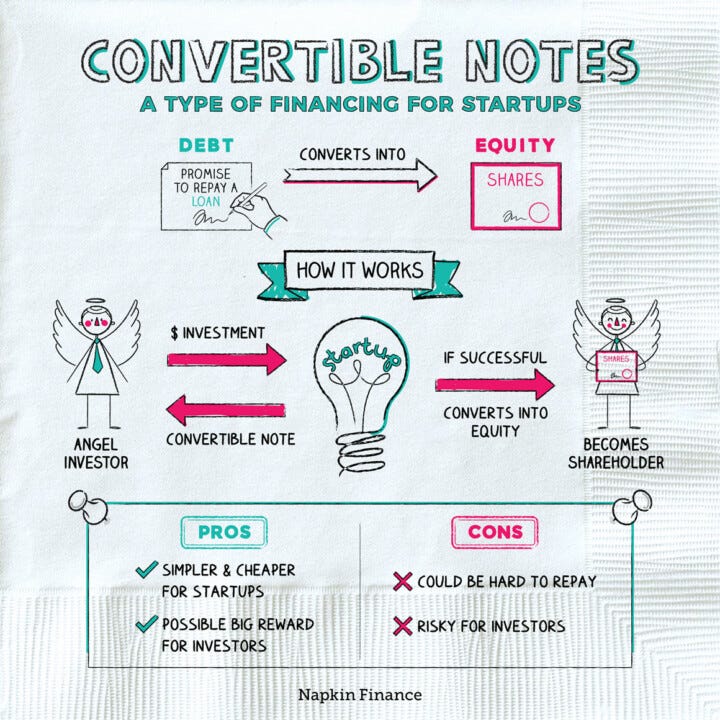Never express your ‘Use of Funds’ slide as percentages, why? | VC Remote Jobs & More
You’re Raising For Milestones, Not For Percentages or Runway.
Hey, Sahil here! Welcome to this bi-weekly venture curator newsletter. Each week, I tackle questions about building products, startups, growth, and venture capital! In today’s newsletter, we dive into -
Today At Glance
Deep Dive: Never Express Your ‘use of funds’ Slide As Percentages.
Featured Post: A Simple Paragraph Every Entrepreneur Should Add to Their Convertible Notes!
Major News In Ecosystem: Chamath's $1 Billion VC Fund, FTC Probes Giant Firms Investment In OpenAI, World's Most Valuable Edtech Startup Reduce Valuation by 99% & More.
Must Read on Startups, Venture Capital & Technology
VC Jobs & Internships: From Scout to Partner
FROM OUR PARTNER
Close Your Round Faster With Flowlie’s Fundraising Hub.
Fundraising made simple…
Flowlie combines expert advice with software to help early-stage founders plan, prepare, and execute their fundraising strategies.
✨ No connections in VC? No problem -
Whether you’re a first-time founder or have successfully fundraised in the past, we’ve got you covered.
📆 Book Your Free Fundraising Consultation Now & Get advice on your round and learn how Flowlie can help you design the right capital stack for your business.
🤝 PARTNERSHIP WITH US!
Want to promote your startup to our community of 21,500+ entrepreneurs and investors? Fill out the form, our team will reach out to you.
🎉Get A Discount of 20% For Multiple Ads
TODAY’S DEEP DIVE
Never Express Your ‘Use of Funds’ Slide As Percentages.
When investors look at a startup slide deck, they are looking for something very specific. Yes, they want to know if the team is great the market is huge and the problem is worth solving and the solution makes sense. Of course. But another thing -
They are looking for is whether the founders understand the journey they are on.
(Every day, I receive tons of pitch decks, and this is one thing I feel is missing from most PITCH DECKS…)
If you step on the VC treadmill, you’re signing up for rapid, explosive growth. You have to: If you don’t, you don’t fit into the models of how VC works. And that’s OK — not every company is suitable for VC funding.
The other truth is that your funding amount includes a very literal deadline: If you run out of money, that’s the end of your company. So, before you run out of money, one of three things needs to happen:
You have an exit event, which usually means getting acquired or going public through an IPO. The latter is more predictable than the former, and early-stage companies usually don’t have that as an option.
You reach break-even and can operate the business from cash flow. In other words, you are making more money than you are spending.
You raise another round of funding.
For early-stage companies, the first two options are off the table, which means you need to paint a compelling picture for another round of funding. That’s where startups often fall. Here’s how to fix that.
Red flag: Percentages, Not Milestones
The first red flag is that the company is expressing what it will spend the money on as percentages (common slides in every pitch deck). To a degree, that makes sense for how you plan your internal budgets.
But as an investor, I want to know that the company focuses on activities that fulfil that third objective: raising funds.
That means that in effect, a startup needs to think two funding rounds ahead when raising money: what you need to raise for this round, and the amount you will need for the next round, which will probably happen between 18 and 24 months from now.
The problem I see with this slide is that it’s not clear whether the founders know the rules of the game they are in. Are they aware of how different the company needs to be for it to raise its next round? Are they sure $5 million is enough to get to where they are going?
There’s a cheat you can do here:
Imagine what your company needs to look like to raise your next round -
How much tech do you need to have developed?
How many customers and how much revenue do you need?
What staff do you need to develop that tech, sell to those customers, and support them?
What else do you need to make that a reality?
Then put a price tag on all of that and add a safety buffer of 20% to 40%, and that’s the amount of money you need to raise.
In other words: You’re raising for milestones, not for percentages or runway.
Red flag: Where Is The Value Increase Going To Come From?
Most tech startups become more valuable because the technology they develop makes something in the world better. Many companies start as so-called concierge MVP companies, which is both appropriate for the stage of the company and answers a thesis. Ultimately, the goal for both of these things is de-risking the company in some way (which can then be expressed as traction).
For some companies, value increases can come in terms of hard metrics: revenue, customer growth, average spending, customer retention, etc. However, the leverage in a startup is the technology that facilitates this growth.
That brings me to the second red flag on this SaaS company slide: Spending 60% on operations makes me think that this is a very crooked company. What is it doing that requires it to be so operations-heavy? Similarly, spending only 10% on R&D is wild.
For most early-stage startups, those numbers are reversed: You are investing heavily in developing new technology, a little bit in marketing and sales, and as lightly as you can in the underpinning operations of the business. Ideally, you design as much of the operations out of the business as you can, replacing it with software. That’s because software scales in ways that humans do not.
In this slide, then, what I see is a company that has made some poor choices, leading it to rely heavily on operational costs rather than software and development. It is also continuing to make poor decisions: Those numbers aren’t backwards-facing; they are saying that this is how the company is planning to spend its money.
Worse: At the end of 18 to 24 months at that spend, it isn’t clear whether the company will be able to raise its next round of funding.
What might this look like?
If you look at this slide -
The difference is stark. Now the slide shows that the company understands the important levers in its business. Reducing the CAC (customer acquisition cost) means that the company gets more bang for its marketing bucks.
Customer growth from 4,000 to 15,000 is significant. At a CAC of $290, that would cost $2.6 million. If it is instead able to obtain those customers at $220 per customer, the cost would be $2.1 million. That’s half a million dollars saved on customer acquisition. Or, if it still spent $2.6 million, it could add 11,000 customers instead of 9,000.
Growing the lifetime value (LTV) per customer from $1,500 to $2,500 means that the overall value of the 15,000 customers goes from $22 million to $37 million, definitely moving the business in the right direction.
The key hires show that this particular company understands that security is a major factor in its business (we’ve given you no context for this business, but let’s assume that is true), and a new head of marketing — which makes sense, given the focus on customer and LTV growth and CAC reduction.
The question becomes:
Would this business be able to raise its next round? Well, let’s do the math.
Would a company with a headcount of 25, with an ARR of $9 million, and 15,000 customers be able to raise a round that follows a $5 million round?
Presumably, this would be a growth round in the $15 million to $20 million range, and given everything I know about the way these things work, I’d give them pretty decent odds at that fundraiser.
This slide shows that the founders are raising a sensible amount, have a clear mission for what they need to do, and are referring to specific product development targets they are planning to hit ahead of the next fundraising round.
Red flag, thine new chromatic representation shall be green; we’re good to go.
FEATURED POST
A Simple Paragraph Every Entrepreneur Should Add to Their Convertible Notes!
Young entrepreneurs often get screwed by their angel investors on convertible notes and I know I can’t convince you not to do it so I’d like to offer one simple bit of advice.
When you do a convertible note with a cap that converts into the next round of funding one of the unintended consequences is that if you’re successful and raise at a larger price than your cap the early angels often get “multiple liquidation preferences” on their dollars in. … Read More Here
Join 14000+ Founders, Investors and Startup Enthusiasts Getting Tactics To Build, Learn and Implement About Startups and Venture Capital.
THIS WEEK’S NEWS RECAP
Major News In VC, Startup Funding & Tech
Byju's, the world's most valuable Ed-tech startup cutting its valuation by 99%. Read More
Y Combinator president, Garry Tan, sparked controversy with profanity-laden posts on social platform X. Read More
Investor Chamath Palihapitiya is no longer raising a $1 billion fund. Read More
FTC Investigating Amazon, Google’s and Microsoft Investment In OpenAI and Anthropic.' Read More
Figma's Valuation Reduced From $20B to $10B. Read More
→ Want to receive Daily Morning Venture Insights, Funding Updates And Startup Stories In Your Inbox? Subscribed To the Venture Daily Digest Newsletter and join 8500+ Avid Readers!
WHAT I READ THIS WEEK
Must Read on Startups & Venture Capital
The Fastest Growing Software Sectors in 2024 by Tomasz Tunguz. Read Here
Are startup valuations good by Carta? Read Here
Fundraising tips: How To Answer 'Why Now?' Read Here
Why Entrepreneurs Try To Pump Up Their Market Size? Read Here
Silicon Valley's Cargo Culting Problem. Read More
What Does It Take To “Do Things That Don’t Scale” For Your Startup? Read More
TODAY’S JOB OPPORTUNITIES
Venture Capital Jobs & Internships
Venture Capital Investor - Fundamental | Germany - Apply Here
Investment Associate - Connecticut Innovations | US - Apply Here
Associate: Talent Investor - Entrepreneur First | India - Apply Here
VC Fellow - 30N Venture | USA - Apply Here
Social Media Marketing Intern - Popstar Venture | USA - Apply Here
Head of Operations - Root Ventures | USA - Apply Here
Investment analyst - Exfinity venture partners. | India - Apply Here
Investment Analyst - Peak XV Partners | India - Apply here
VP - Nordstar | UK - Apply Here
Investor Relations Manager - Frontline | UK - Apply Here
Intern - France | France - Apply Here
2024 MBA Summer Internship - 25Madison | USA - Apply Here
VC Intern -Riverwalk Holding | India - Apply Here
Associate - The Partnership Fund | USA - Apply Here
→ Want Daily Updates on VC Job Opportunities? Check out VC Crafter 👇
Join our 200+ VC Enthusiast Community - VC Crafters - To Access the VC Network, Job Opportunities, and Weekly events on understanding the VC Industry!
That’s It For Today! Will Meet You on Thursday
Happy Tuesday! 🥂
Advertise || Investor Database || Break Into VC
✍️Written By Sahil R | Venture Crew Team












